Woodbridge: Difference between revisions
Knorrepoes (talk | contribs) No edit summary |
Knorrepoes (talk | contribs) m (Text replacement - "Literature : " to "'''Literature''': ") Tags: Mobile edit Mobile web edit |
||
| Line 21: | Line 21: | ||
{{media}} | {{media}} | ||
[[Literature]] : Image and information from [http://www.civicheraldry.co.uk here] | [[Civic Heraldry Literature - United Kingdom|'''Literature''']]: | ||
Image and information from [http://www.civicheraldry.co.uk here] | |||
[[Category:United Kingdom Municipalities W]] | [[Category:United Kingdom Municipalities W]] | ||
[[File:england.jpg|50 px|link=United Kingdom]][[Category:England]] | [[File:england.jpg|50 px|link=United Kingdom]][[Category:England]] | ||
[[Category:Granted 1975]] | [[Category:Granted 1975]] | ||
Revision as of 13:57, 7 January 2024
| Heraldry of the World |
| British heraldry portal Civic heraldry of the United Kingdom |
|
WOODBRIDGE (Town Council)
Incorporated into : 1974 Suffolk Coastal] (2019 East Suffolk)
Official blazon
Arms : Per bend Argent and barry wavy Argent and Azure a Bend Gules charged with three Escallops Argent in sinister chief a Rose of the species Rosa Damascena Var Omar Khayyam flowered slipped and leaved proper.
Crest : On a Wreath Argent and Gules on the Stump of an Oak Tree sprouting proper a Cock Vert head to the dexter in front of a Cock Or head to the sinister both beaked legged combed and wattled Gules.
Motto: 'PRESERVATION AND PROGRESS'.
Origin/meaning
The arms were officially granted on May 12, 1975.
The blue and white waves symbolise the River Deben and were seen on the device previously used bt the Town Council, as were the silver scallop shells on red. These are taken from the arms of Thomas Seckford, who was Woodbridge’s most influential citizen and greatest benefactor, rising to power in the reign of Mary Tudor. In 1575 he built the Shire Hall in Market Hill, which now houses the offices of Woodbridge Town Council. They can also been seen as a reference to the Town’s maritime interests and its long history as a port. The rose commemorates Edward Fitzgerald’s residence in Woodbridge during the 19th century, he is most famous for his translation of the 11th century Persian poem "The Rubaiyat of Omar Khayyam". He was buried in Boulge churchyard and the rose tree over his grave came from hips brought from Omar Khayyam's grave at Naishapur.
The oak stump refers to the wooden bridge from which the Town is said to derive its name. It is also a reference to the building of warships and pleasure craft over the centuries. The cockerels are taken from the ancient crest recorded for the Seckford family at the visitation of Suffolk in 1561 and 1577.
Contact and Support
Partners:
Your logo here ?
Contact us
© since 1995, Heraldry of the World, Ralf Hartemink 
Index of the site
Literature:
Image and information from here













